RA-2 Overview
Applications
RA-2 had an essential role to play in the Envisat mission. Operating over oceans, its data was used to monitor sea surface topography, thereby supporting research into ocean circulation and sea-level change, as well as providing observations of the sea floor structure or shape, and marine geoid characteristics. It was also possible to determine near-sea-surface wind speeds and significant wave heights, data that are important for both weather and sea-state forecasting.
RA-2 was also be able to map and monitor sea ice and polar ice sheets, allowing the energy/mass balances of the world’s major ice sheets, including the Antarctic, to be better determined. In addition to operating over oceans and ice, RA-2 could also be used over land surfaces. From its observations of range and reflectivity, it was possible to determine land surface elevations, and surface characteristics.
Oceans
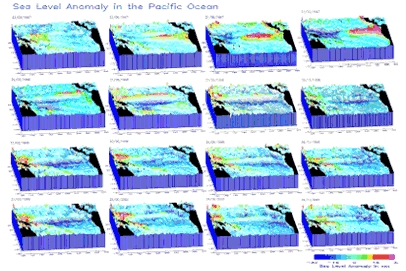
The ocean covers 70% of the planet and plays a key role in regulating the global climate. The ocean is the main reservoir for heat as well as a powerful vehicle to transport warm water masses poleward. It has the capacity to intake (but also reject) significant amounts of carbon dioxide, one of the greenhouse gases. It also supports a cost-effective type of transportation of goods, is a milieu where to discover new oil fields, is a feeding ground for fish and sea-food to nourish the ever-growing human population.
The oceanographic mission objectives of Envisat were derived from the ERS results. To resolve low frequency signals in the ocean spectrum and to further understand oceanic processes a longer time series was, however, needed. The oceanographic mission objectives of Envisat altimetry were dynamic topography monitoring, mesoscale variability, seasonal and interannual variability, mean global and regional sea level trends, marine geophysics -especially in polar oceans even covered with sea-ice-, sea-state monitoring. The objectives were to be met with data products available either in near real time (3 hours), in quasi near real time (2-3 days) or with the highest precision off-line products (50 days).
Seasonal and interannual variability has an important impact on climate. Planetary waves propagate from months to seasons across basins to adjust the ocean in response to wind forcing. Interannual variations of the seasonal or annual cycles have a direct and sometimes dramatic impact of the global climate, well illustrated by the El Niño-Southern Oscillation (ENSO). The data serve mainly to tune and evolve global ocean and atmosphere models, to better understand the ocean-atmosphere interaction and the underlying processes.
The ocean is vast and hosts a full spectrum of signals. One orbiting satellite alone cannot pretend to cover that spectrum. There are significant advantages in merging the data from two or more Altimetry missions sampling the Earth with different orbital patterns. A good illustration is the enrichment in space resolution of the mesoscale variability field computed with merged data from ERS and Topex-Poseidon which were in the same orbital configuration as Envisat and Jason.
Snow and Ice

Polar ice sheets and sea ice play a vital role in the global climate system due to both their effectiveness in reflecting incoming solar radiation, and as a huge store of freshwater. Sea ice acts as a barrier between the ocean and the atmosphere, cutting off exchanges of heat, moisture and momentum. Brine expulsion during seasonal sea ice formation and intense cooling of the sea surface through polynyas drive the thermohaline circulation of the oceans. This process creates the dense bottom water in the Pacific, Indian and Atlantic Oceans. It is responsible for the poleward transport of heat in the North Atlantic, which ensures mild winters for Western Europe.
This critical component of the climate system was not well represented in climate models before Envisat was launched but is clearly important if accurate predictions of the consequences of global warming are to be made. Global warming was predicted to be greatest in the Arctic region. If Arctic sea-ice is lost, it could change the circulation pattern of the North Atlantic resulting in severe winters for Western Europe. Melting of the Greenland and Antarctic ice sheets would contribute to global sea level rise.
The vast, remote and inhospitable polar regions can only be effectively monitored through a global remote sensing system. Polar regions experience between 50 and 90% cloud cover and spend long periods in darkness, which limits the observations of optical and thermal infrared instrument. However, this task is particularly well served by satellite-borne active Radar instruments.
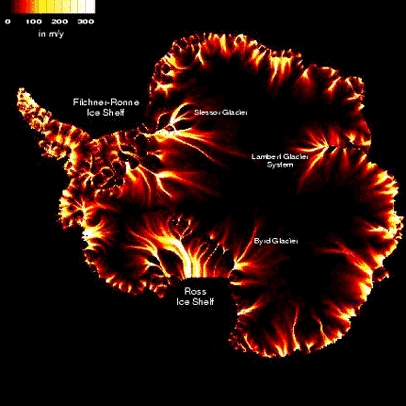
Techniques developed using the ERS Radar Altimeters allowed the monitoring of ice sheet mass balance and the derivation of sea ice thickness through the measurement of freeboard. Continuous altimetric measurement of the Antarctic ice sheet since 1992 has revealed a significant thinning of the Pine Island Glacier in the West Antarctic It was important to continue this monitoring with the Envisat RA-2 to establish if this retreat would accelerate the mass discharge from the West Antarctic Ice Sheet.
Balance velocities, i.e., depth-averaged velocity required to maintain the ice sheet in a state of balance at a given point for a given surface mass flux, were estimated over the Antarctic grounded ice sheet using ERS altimeter data. Balance velocities depend mainly on the surface slope and are modulated by surface mass balance and ice thickness. Their study contributes to the understanding of ice sheet dynamics and their response to climatic forcing.
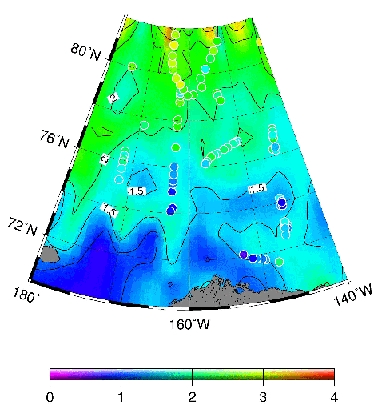
Sea-ice thickness can be sampled using moored or submarine mounted Upward Looking Sonar (ULS). Moored ULS are only sampling a fixed location and submarines tend to sample limited areas for only a few weeks each year. This is not sufficient to deduce full regional and seasonal variations. Freeboard measurement by satellite is the only technique that can measure sea ice thickness at the time and length scales that climate investigation demands.
The technique was developed using ERS altimeter data, verified using the ULS measurements and implemented in the Envisat RA-2 ground processing. Results from ERS suggested that the thinning of Arctic sea ice may be localised. Continued monitoring by the Envisat RA-2 was critical to establish long term trends. The Envisat altimetry mission extended and improved the monitoring of the cryosphere in the climatically important Polar Regions.
Land
Over land, the Radar Altimeter echoes have a non-predictable shape. This is why this field of application has slowly and painstakingly matured. A remarkable result from the ERS-1 Geodetic phase was the Altimeter Corrected Elevation Model ACE [Berry et al., 2000] which replaced more than 28% of the most precise Global Digital Elevation Model with an altimeter derived height dataset and corrected another 17%. The Envisat altimeter, even though it did not fly an orbit as dense as the ERS-1 Geodetic mission, enhanced this result in terms of accuracy and new areas never measured before, thanks to its enhanced tracking capacity.
Another land application that has been painstakingly attempted since SeaSat is river and lake levels monitoring. Radar altimetry is a powerful tool for this application as it unifies all the worldwide river and lake level measurements, even the ones most remote or inaccessible, with a unique gauge. Being able to measure the global river levels, be it only once or twice a month would be a significant contribution to hydrology. It was demonstrated with ERS altimeters that echoes from an continental water surface are clearly discernible and convertible to river or lake levels.
The inclusion of an Ice mode on ERS-1 and ERS-2 led to a huge increase in the percentage of the Earth's land surfaces from which valid altimeter echoes were obtained. This also resulted in coverage of the majority of the world's river systems, offering the possibility of a ten-year time series of river height data. The inclusion of a third tracking mode on Envisat further increased the land hydrology potential of altimetry with even greater river coverage, as well as continuing the hydrology time series.
To illustrate the ERS/Envisat contribution, the image in this section shows part of the Amazon River system, with 35-day river crossings from ERS-1 superimposed on an altimeter derived rivers map. The image was produced by P. Berry, De Montfort University, UK.
Design
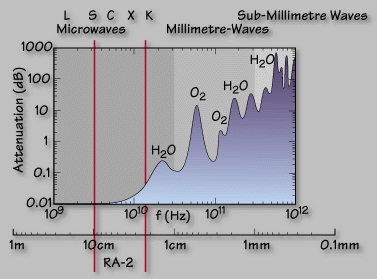
The routine operations of the RA-2 were straightforward: when the instrument was in continuous operation it performed autonomous switching of resolution and mode according to its real time echo analysis. As well as geophysical measurements, the instrument performed a number of internal calibration and characterisation tasks. Some of these were performed autonomously according a built-in schedule, and some on command. The main nominal frequency of 13.575 GHz (Ku Band), which had been selected as a good compromise between the affordable antenna dimension that provided the necessary gain and the relatively low attenuation which experience the signals propagating through the troposphere.
Technical Characteristics
- Accuracy: Better than 4.5 cm, Wave height: better than 5% or 0.25 m
- Spatial Resolution: 20 km IFOV Altitude: 800 km
- Swath Width: Scanning technique: Nadir-only viewing, continuous sampling along track
- Waveband: 13.575Ghz (Ku-Band) & 3.2GHz (S-Band)
- Mass: 110 kg
- Altitude: 764 km to 825 km with an accuracy of <4.5 cm (highest resolution)
Design Concept
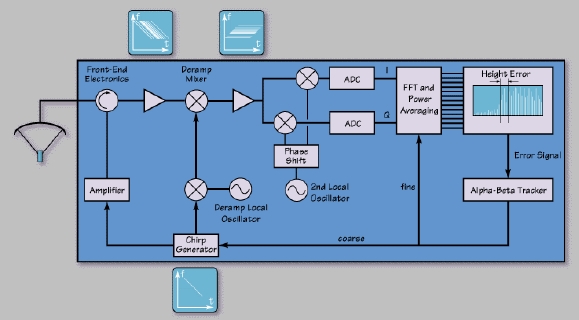
With RA-2, a clear distinction was made between the robust collection of accurately quantified radar echo data (this tracking was a primary function of the instrument), and the interpretation of these data as meaningful geophysical quantities (this is only the task of the on-ground processor). Previous altimeters merged these functions in the on-board tracker, thus increasing the constraints on its optimisation.
Interpretation of the measured radar echoes could be performed with more or less accuracy according to the surface characteristics. The best results were obtained over the ocean, which was spatially homogeneous, and with a surface which followed known statistics. Surfaces which were not homogeneous, and with discontinuities or strong slopes such as some land surfaces, allowed less accurate interpretation. RA-2 transmitted microwave pulses which propagated at a speed determined by the refractive index (see below) of the propagation medium, which was close to unity. The time elapsed from the transmission of a pulse to the reception of its echo reflected from the Earth's surface was proportional to the satellite's altitude. The magnitude and shape of the echoes contained information on the characteristics of the surface which caused the reflection.
The RA-2 measured the power level and time delay of 128 samples of echoes from ocean, ice, and land surfaces. It was optimised to maintain the leading edge of this echo in the range window. This was achieved by one of the new features on RA-2 compared to ERS-1: A model-free tracker in the on board signal processor. Window position and resolution were controlled by algorithms developed to suit the tracking conditions. Adaptive height resolution operation was implemented by selecting the transmitted bandwidth. As a result, measurements over ocean were carried out with high accuracy at the highest resolution. Over land or ice or during transitions from one kind of surface to another the tracking was maintained accepting sometimes a certain degradation of the height resolution.
Echo samples were processed on ground to account for correction and calibration data. Altitude, surface topography, and reflection coefficients of all kinds of Earth surfaces could be derived. Algorithms based on models were used to estimate altitude over various surfaces, and wind speed and significant wave height over the oceans.
RA-2 transmitted frequency modulated pulses (chirp) pulses. This frequency modulation was a coding of the signal which spread the energy of a short pulse over a longer time interval, thus allowing reduced peak power in the pulse.
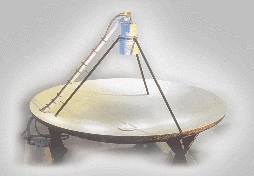
The transmit pulses, which were generated in the chirp generator (by means of SAW RAC) were amplified by either Ku-band or S-Band amplifiers, depending on the selected transmit frequency. The Ku-band HPA used a traveling wave tube whilst the S-band transmitter applied the solid state technology. The Ku-band front end electronics (KFEE) or the S-band front end electronics (SFEE) fed the signals to be transmitted to the antenna which was designed as a dual-frequency parabolic antenna.
The radar echo was composed of a large number of replicas of the transmitted chirp signal, reflected from the facets of the surface below. When the echo from the surface was expected to return (about five milliseconds later, depending of the altitude of the satellite), the chirp generator was activated again. This time the chirp signal had a different path: it was up-converted and routed to the first mixer in the receiver, where it became the intermediate frequency signal (IF signal). In mixing the return echo signal with the IF signal, time delays in the echo were mixed down to constant frequency tones. Thus, mapping of the return pulses from the time domain to the frequency domain was achieved.
The resulting signal was filtered, amplified and down-converted. A phase detector produced the baseband in-phase (I) and quadrature (Q) components. These signals were fed to the signal processing subassembly (SPSA) where they were sampled and digitised. Then, a 128-point complex fast Fourier transform, square-modulus extraction and averaging (over 100 echoes) were applied to the samples to produce an averaged signal power spectrum.
In the SPSA software a robust tracking algorithm kept the leading part of the echo spectra (independent of their shapes) within the sampling window. It did this by appropriate timing of the deramping chirps such that they will coincide with the echo signals and, if necessary, by appropriate adaptation of the chirp bandwidth and thereby of the sampling window resolution. This allowed to track all kinds of Earth surfaces with an optimum adapted height resolution. There were three chirp bandwidths available: 320MHz, 80MHz and 20MHz. In general, the tracking was performed with the highest possible resolution (corresponding to 320MHz). A second tracking algorithm controlled the receiver gain.
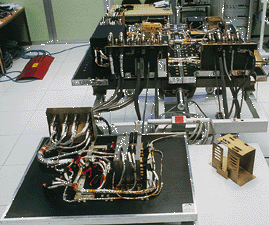
For the initialization of the tracking and, after loss of tracking, an acquisition routine detected the radar echoes and preset the tracking parameters in order to allow the start of the tracking. The indication of loss of track with the following acquisition, and transitions between acquisition and tracking, were performed autonomously. The acquisition used unmodulated radar pulses.
Simultaneously to the tracking, the RA-2 periodically performed internal calibration measurements. For this, the transmit pulse was coupled into the receiver by means of a calibration coupler (-100 dB) within the front end electronics. The signal was amplified, deramped, filtered, etc., as the normal radar echo signals were. The power spectrum of this signal, which was extracted by the SPSA, represented the point target response of the instrument thus indicating all residual errors and distortions in the transmit/receive path (except the antenna and the antenna feeders which had to be characterized separately on ground).
All measured data, the radar echo spectrum samples, the point target response spectrum samples, etc., together with auxiliary data which were necessary for the evaluation of the measured data, e.g., the instrument parameter settings, measurement datation data and others were sent to ground for further processing. On command, the RA-2 was able to transmit also bursts of single radar echo samples (ADC outputs) to ground.
Return echo

Radar pulses transmitted from the satellite were radiated in a spherical shell whose intersection with the surface defined an instantaneous illuminated area.
A flat surface which was roughly on the scale of the radar wavelength (in centimetres) was a diffuse scatterer. Reflected energy from a flat diffuse surface is proportional to the illuminated area. Resulting from the constant area of the expanding annulus, the averaged return exhibits a linear initial rise, followed by a plateau region, which eventually was attenuated by the fall-off of the antenna pattern off-boresight. We define the instant at which the leading edge of the spherical shell just touches the surface (or in fact the time this echo arrives in the altimeter) as a time origin (t = 0).
Now consider that the surface is slightly rough due to ocean waves. The roughness scale is a few times (although the same order of magnitude) the pulse length (c . tau; where tau is the compressed pulse). Then the leading edge of the pulse will illuminate the peaks of the roughness earlier than before, and therefore there will be echo energy returned to the altimeter earlier than t = 0. The same reasoning applies for the trailing edge of the pulse, and so the echo strength at time will be slightly less than for a perfect flat surface. The diameter of the footprint is therefore larger, and the duration of the leading edge of the echo is proportional to the surface roughness.
A modeling of the echo under these conditions was built by Brown (1977), and this Brown model is widely used in the altimeter community so far. In this model the power envelope of the echo is described by the convolution of the system point target response, the antenna pattern, and the height distribution of surface scatterers. In the Brown model these functions are all taken to be gaussian. Other models developed later, such as the Hayne model (Hayne, 1980), are based on the Brown model but include skewness in the gaussian assumption of the point target response and in the height distribution of scatterers.
Non-ocean surfaces
Non-ocean surfaces are characterised by a height distribution of scatterers which is not easily described by statistical or analytical models. They can have abrupt altitude changes and large-scale slopes. Over such surfaces the form of the echo is determined by the range to the different scatterers, their reflectivity, and their position in the antenna pattern. This results in echoes of unpredictable shape, which change rapidly. RA-2 offered reliable tracking of such echoes and their interpretation into geophysical results will provide interesting data.
Refractive index corrections
The radar altimeter measured the time delay of the echo. This can be interpreted as range or altitude, knowing the speed of radar wave propagation, which means that the refractive index of the propagation medium must be known. At the primary frequency of 13.575 GHz the main contributors are oxygen, water vapour, and the ionosphere.
Oxygen
The refractive index of oxygen is the largest contributor, partly because the integrated column density is greater. It accounts for over two metres of range correction. The effect can be estimated with an error of about 0.2% from a simple expression depending only on sea level atmospheric pressure and the local acceleration due to gravity. The atmospheric pressure field is available as forecast and analysed fields from European Centre for Medium-Range Weather Forecasts (ECMWF).
Water vapour
The effect of water vapour is smaller than oxygen, but much more variable. It can range from virtually zero over the high, dry ice caps, to about 40 cm in tropical regions. Over oceans the water vapour column density is measured by the on board microwave radiometer. Over other surfaces the extraction of the water vapour signature from the microwave radiometer (MWR) is less accurate and forecast or analysed fields must be used.
Ionosphere
The ionosphere, a low-density cold plasma, has four effects on electromagnetic waves:
- phase advance and group delay
- rotation of the polarisation ellipse (Faraday rotation)
- phase and amplitude scintillation
- ray path bending
At microwave frequencies the magnitude of the effects depends on the total electron content (TEC) along the path, and the first two can be used to measure the TEC. Of these four effects, the group delay caused errors for RA-2 and DORIS. It was inversely proportional to the square of the frequency. This allowed it to be evaluated by using the second frequency channel of 3.2 GHz, where the ionospheric influence is much larger.
Tracking Concept

To be able to implement the full-deramp technique properly the chirp generator needed to be triggered at the exact instant when the echo was expected to return. The process of ensuring this is called tracking.
The tracking function needed to keep the return pulse within the range window. When this function failed, tracking was lost and the echo signal would have to be be acquired again. Tracking involved the derivation of an error signal proportional to the offset of the echo from the tracked point of the range window. Due to the speckle inherent in the signal the error signal is noisy and must be smoothed in a low-pass filter. In order to allow prediction of the echo return instant in the general case where it is changing, e.g., due to the satellite height rate, a second order filter was used for RA-2.
Tracking and estimation
In all altimeters prior to RA-2, the output of the tracker was equivalent to the estimate of the range above the ocean surface, because the algorithm used to generate the error signal had been optimised for this purpose. The disadvantage of this approach is that such algorithms tend to be poor at generating error signals in non-nominal conditions and are susceptible to loss of track.
The algorithm used in RA-2, the model-free tracker, MFT, had been optimised to generate linear error signals with a wide range of echo characteristics. The consequence of this design is that the estimation of the range had to be performed off-line using the echo waveforms. This increased demand on the ground processing was compensated by the significant increase in the robustness of the tracker. There was a clear separation between tracking and estimation in RA-2.
The Envisat alpha-beta tracker
![]()
There were two requirements on the design of the RA-2 alpha-beta tracker. First, it needed to perfectly follow a constant slope of the height; and second, it needed to account for the time lag due to the filter computation time. Both of these were achieved.
The alpha-beta tracker was a filter which had two important tasks. It was a low pass filter, but it also had the difficulty of having to change the rate from the input to the output. Therefore the clearest approach was to differentiate both tasks as much as possible. This was a guideline in the design of the alpha-beta filter for RA-2.
The image in this section distinguishes the stage dedicated to the filtering function from the stage dedicated to the extrapolation function.
The inputs to the linear interpolator stage (alpha and beta branch) were updated at PRF/NA rate, every time a discriminator output was available. In order to get output values at Pulse Repetition Frequency (PRF) rate, necessary for the tracking loop closure, a linear interpolator was employed; this also allowed the delay to be compensated due to the time required to compute the error signal from the averaged echo waveform.
Model-free tracker
The RA-2 tracker, or to be precise the algorithm which generates the error signals which drive the tracking loops, has been designed for robustness and to be able to generate all necessary control signals. It is not based on any model of the return echo, and is therefore called the model-free tracker (MFT). It is based on an algorithm called offset centre of gravity (OCOG) which will be described first.
Offset centre of gravity
![]()
The Offset centre of gravity (OCOG) algorithm is based on the assumption that the echo envelope can be approximated by a rectangle.
The steps in the process are:
- find the centre of gravity (COG) of the echo
- set the echo power estimate (rectangle height) at double the COG power
- find the total of all samples: this is the area of the rectangle
- from the height and area find the width of the rectangle
- the width of the rectangle and its centre (of gravity) define the leading edge position
- the deviation of the leading edge from the centre of the window is the height error
The OCOG height error forms a position estimate by locating the centre of gravity of the return within the range window, and then offsetting the tracking point by half of the signal width estimate W, a technique which gave rise to the name.
It must be noted that, in the OCOG approach, it is not known where the echo starts and stops in the range window: the only information available is the width. Then the algorithm assumes that the echo is positioned symmetrically with respect to the centre of gravity.
As expected (due to the linear weighting with distance introduced by a centre of gravity calculation), the sensitivity of the position estimator to the average noise power is quite bad. The solution proposed by the algorithm designers to mitigate this problem consists of artificially increasing the dynamic range of the samples by squaring them prior to the computation.
Model-free tracker summary
The Model free tracker (MFT) applies a threshold to the radar echoes and transforms them into a binary sequence of samples. The amplitude, duration, and time position of the centre of gravity of this sequence, with respect to the radar tracking window, are computed according to the OCOG algorithm. The computational load required by the algorithm is in this case greatly reduced because of the binary nature of the signals.
The computed parameters are used to generate the errors signals which control the height and gain loops. The error on the time position of the center of gravity, which is linear over a very broad range, is used to autonomously control the radar resolution. Therefore when this error becomes too large and the radar echo is exiting the tracking window, the altitude resolution is degraded and, as a result, the tracking window is broadened to recapture the radar echo.
Adaptive height resolution is implemented by changing the bandwidth of the transmitted signals among the values provides by the chirp generator.
The MFT algorithm is characterised by a linear error characteristic, by good performance even at low SNR (in the order of or less than 0dB), and by independence from the waveform shape.
Sensor Modes

RA-2 was a nadir looking pulse limited radar functioning at the main nominal frequency of 13.575 GHz (Ku band). A secondary channel at nominal frequency of 3.2 GHz (S band) was also operated to compensate the range error on altitude measurements caused by the propagation of the radar signals through the ionosphere. The main mode of instrument operation was the TRACKING mode. During this mode all instrument units were powered-on and operative. The main task was tracking echo waveform which was executed without interruption.
The RA-2 was provided with three different bandwidths (three different Ku resolutions):
- 320 MHz, with a resolution of 47 cm and tracking window width of 61 m
- 80 MHz, with a resolution of 190 cm and tracking window width of 243 m
- 20 MHz, with a resolution of 750 cm and tracking window width of 960 m
This allowed the resolution to be adapted to different scenarios (ocean, ice, ice-sheet, sea ice and land). The change of resolution was done autonomously by the instrument.
RA-2 operated also in a mode called Intermediate Frequency (IF) CALIBRATION mode with the aim of retrieving the shape of the IF Filter impulse response spectrum needed to compensate for the distortion on the RA-2 waveforms. Download an ESA bulletin for more detail on this mode.
Mission Operations
The Envisat mission ended on 8 April 2012, following the unexpected loss of contact with the satellite. The data products considered as valid for altimetry started on 14 May 2002. From April 2002 to October 2010, Envisat's orbital period was 35 days, the same as ERS-2 and some of the ERS-1 phases. The RA-2 S-band module was definitively lost on 18 January 2008.
To ensure an additional three year lifespan, the Envisat satellite moved to a new lower orbit on 22 October 2010. From 2 November 2010, for the Envisat extension orbit, the ground track changed and consequently the repeat cycle changed: 30 days with 431 orbits per cycle instead of 35 days with 501 orbits per cycle. A few weeks after celebrating its tenth year of service, the Envisat mission effectively ended on 8 April 2012, following the unexpected loss of contact with the satellite. ESA declared the official end of mission on 9 May 2012.
- Download a table which provides the list of events affecting the RA-2 mission during the Envisat lifetime
- Download the document IDEAS - RA2/MWR/DORIS instruments events during Envisat mission for more information